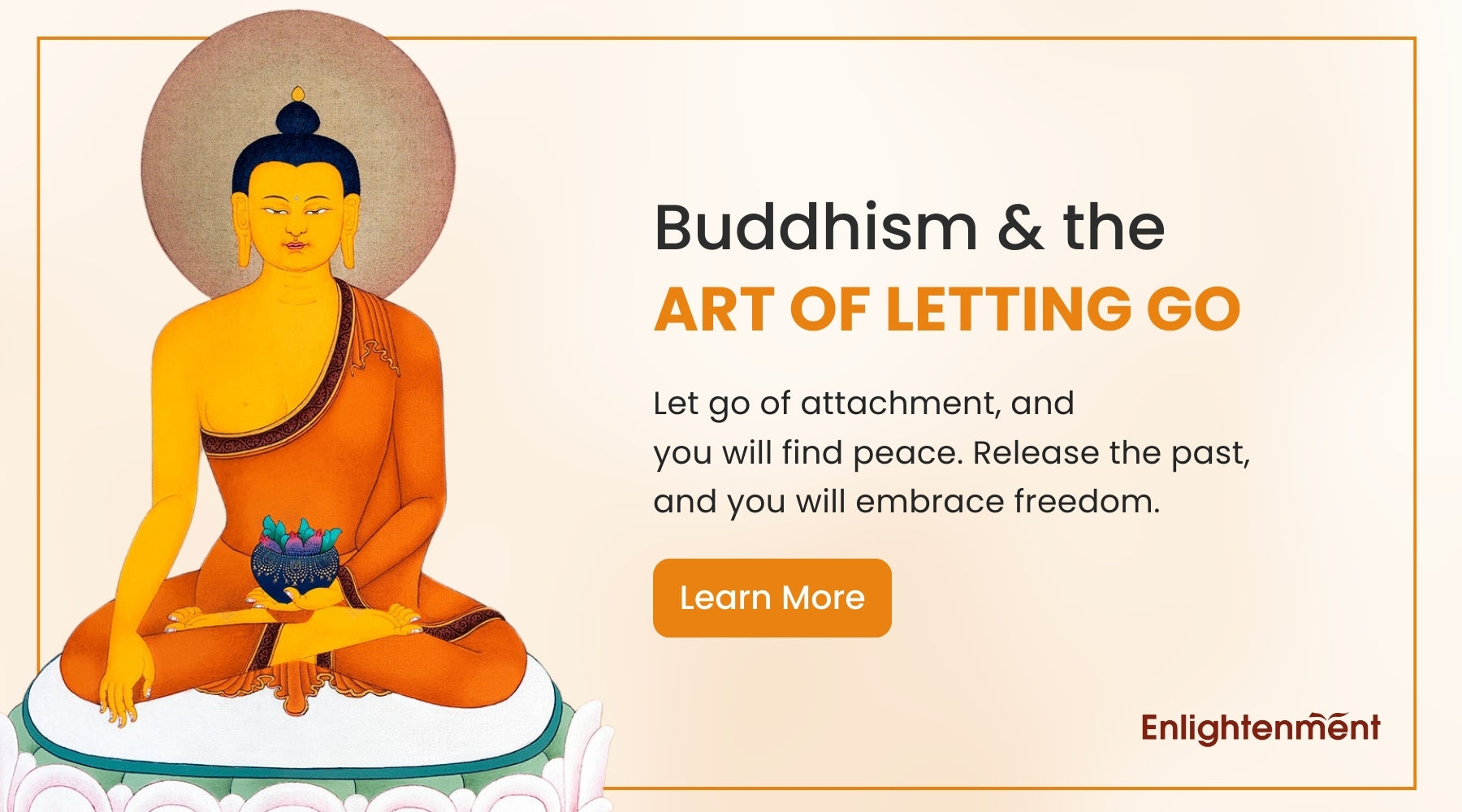-
Introduction
-
The Philosophy Of Letting Go in Buddhism
-
The Nature of Attachment
-
Impermanence and Non-Self: Transforming Attachment into Freedom
-
Buddhist Practices to Cultivate Letting Go
-
Modern Relevance of Letting Go
-
Why Is It So Hard to Let Go?
Introduction
In the modern world, where everything is a race against time, life sometimes seems to be a continuous run. We look forward to more victories, acquiring more things we think will complete our lives, and seeking more relationships to satisfy us. But sadly, most of us come to work with stress, anxiety, and dissatisfaction. The source of such conflict can be found in cling, in attachment – people’s inability to release what is impermanent and transient.
Buddhism, one of the world's most profound spiritual traditions, offers a transformative solution: the art of letting go. Unlike simply losing interest or giving up, letting go in Buddhism is about liberation—releasing ourselves from the chains of attachment that prevent us from experiencing true peace and happiness.
This blog will explore how the Buddhist philosophy of letting go offers a transformative path to inner peace and freedom by releasing attachments to impermanent things.
The Philosophy Of Letting Go in Buddhism
Letting go is a profound philosophical concept in Buddhism, deeply intertwined with understanding suffering, attachment, and the nature of reality. This philosophy encourages individuals to release their grip on desires and attachments, ultimately leading to greater peace and enlightenment.
The Nature of Attachment
A better understanding of attachment, or clinging, as a significant cause of suffering, or dukkha, is central to Buddhist thought. One way this attachment may present itself is through rigid designation of oneself, material possessions, and emotional needs.
Attachment often leads to a cycle of craving and desire. When we become attached to something, we want to possess or experience it repeatedly, seeking to replicate the pleasure or satisfaction it provides. This creates a sense of craving, which can become all-consuming and lead to suffering when the object of our desire is unavailable or lost.
The more we seek to fulfill our cravings, the more we become attached to the object of our desire, perpetuating the cycle of attachment and craving. This cycle can create a sense of dissatisfaction and a feeling of being trapped in a never-ending cycle of seeking and grasping, preventing us from experiencing true contentment and happiness. According to the Buddha's teaching, people experience pseudo-fulfillment through these things and become dissatisfied when they change or are removed.
Impermanence and Non-Self: Transforming Attachment into Freedom
- Impermanence (Anicca)
There is an excellent Quote by Heraclitus. “You can't step into the same river twice.” It states that everything is constantly changing.
Buddhism teaches that there is no permanence: relations, feelings, body, or property. According to this uncompromising nature, holding on to things is pointless because they will constantly shift or cease to exist.
It is not the same thing to accept the idea of impermanence and consequently avoid full enjoyment of life’s pleasures, as to consciously and deliberately enjoy each joy in the moment it is given. By letting go of the need to possess or control, we cultivate a sense of peace and resilience in the face of change.
For example, Imagine a blooming flower. It starts as a bud, blossoms into full beauty, and eventually wilts and dies. The flower’s journey reflects Anicca — nothing stays the same forever, as everything is constantly changing. Similarly, our emotions, possessions, and even life itself are impermanent. Understanding this can help us let go of attachment and accept the natural flow of life.
- Non-Self (Anatta)
Anatta is the belief that people are soulless and selfless. The Buddha taught that people are soulless since everything changes and nothing is permanent. The Buddha acknowledged that we are human beings, but he also held that admitting that we are evolving creatures is the only way to achieve enlightenment.
The concept of anatta is explained to individuals through a significant tale:
We refer to it as Nagasena and the Chariot. In the tale, a monk named Nagasena visits a monarch named Milinda. The king requested Nagasena's name. When Nagasena offered the king his name, he clarified that it was only his name, not who he was.
Nagasena asked the king how he got to their meeting spot since he was perplexed. When the king replied that he had come in a chariot, Nagasena requested that the king explain what a chariot was. The monarch gestured toward the chariot. But Nagasena clarified that the chariot was only made up of many components, including a seat and wheels.
After that, he compared himself to the chariot and claimed that he, known as "Nagasena," was merely a collection of parts. He wanted the king to see that a human being and a chariot are both merely parts. A human, for instance, has a head, heart, lungs, legs, and other parts, and the owner of these parts is identified by their name. However, the individual only exists because the components are all there. No distinct self or soul exists that is not a part of these components.
This helps us understand that the self is not a singular, permanent entity but a collection of constantly changing parts. By letting go of our attachment to a fixed self, we free ourselves from suffering, ego, and the need for control.
Letting go, in this sense, doesn’t mean losing our sense of identity but instead releasing the illusions of permanence and embracing the fluid, interconnected nature of life. We find true peace, compassion, and liberation in this freedom from attachment.
Buddhist Practices to Cultivate Letting Go

Letting go is a fundamental aspect of Buddhist practice aimed at reducing suffering and fostering inner peace. Here are several key practices that can help cultivate the art of letting go
-
Mindfulness Meditation
Mindfulness meditation practitioners are encouraged to objectively and unbiasedly examine their thoughts and emotions. People can let off clinging habits by learning to identify their desires and concerns by concentrating on the here and now. This practice makes a more profound comprehension of impermanence possible by raising awareness of the fleeting nature of thoughts and feelings.
You can see our buddhist ritual, which might help you meditate.
-
The Eightfold Path: A Roadmap to Freedom
- Right View: Understanding the truths of impermanence (anicca), suffering (dukkha), and non-self (anatta). This insight reduces attachment by helping us see that clinging to transient things leads to suffering.
- Right Intention: Setting a clear intention to practice detachment and cultivate compassion. By aligning our mindset with the goal of liberation, we create the foundation for letting go.
Right Effort and Mindfulness
- Right Effort: Letting go requires consistent effort. This involves identifying and replacing unwholesome habits with wholesome ones, such as generosity, patience, and compassion.
- Right Mindfulness: Cultivating awareness of our attachments is key to releasing them. When we catch ourselves clinging to material possessions, relationships, or identities, mindfulness allows us to pause and choose a wiser response.
Meditation and focus are essential for developing the mental clarity needed to see through the illusions of attachment. This clarity empowers us to let go of what no longer serves us.
Click here to learn more about Four Noble Truths and the Eightfold Path.
-
Acceptance and Non-Resistance
Acceptance is acknowledging the feelings and situations without trying to change them. It simply means allowing emotions to be without judgment or aversion. Practitioners can learn to observe and accept the difficulty of emotions or situations rather than resist and gain a sense of freedom from attachment.
-
Renunciation Practices
In Buddhism, renunciation refers to releasing oneself from the mental grasping that causes suffering and relinquishing tangible belongings, reducing distractions, simplifying one's life, and concentrating on what is essential are all aspects of renunciation practice. Deeper relationships with oneself and others may result from this.
Modern Relevance of Letting Go
The experience of Non-Attachment is the principle that every one must apply in a world full of materialism and the mental illness that comes with the modern age. Materialism, power, and perfectionism create constant conflict and dissatisfaction as people search for the next thing to acquire. Non-attachment is the act of letting go because, with it, we shift our goal from external achievements to inner happiness.
The Buddhist philosophy of non-attachment helps foster satisfaction, develop resilience to adversity, and create a feeling of liberation in today’s challenges.
The popularity of mindfulness techniques worldwide, many of which are based on Buddhist teachings, emphasizes how helpful letting go can be in solving modern problems. Methods like mindfulness and meditation help people let go of unhelpful thoughts, regrets from the past, and fears about the future. Science has demonstrated that these techniques lower stress, promote emotional control, and improve general well-being. Letting go allows us to re-establish a connection with the present, which supports a life of clarity and tranquility in a world overrun by incessant stimulus and pressure.
Why Is It So Hard to Let Go?
Letting go is a central part of Buddhism, yet it is often challenging for practitioners. According to Buddhist teachings, the difficulty in letting go stems primarily from attachment, viewed as a significant source of suffering. Attachment, or upādāna, refers to the human tendency to cling to people, things, or ideas in the mistaken belief that they will provide lasting happiness. This attachment arises from a desire for security and control in a world of impermanence. The Buddha taught that clinging leads to dissatisfaction and suffering because the objects of our attachment are inherently transient and subject to change.
Another reason for letting go is challenging, as people fear feeling complete about emotions and situations. Most people fail to admit they have feelings because they think this would overwhelm them. However, as per Buddhist teachings, one can only let go once and if one learns to accept what is there.
Furthermore, many people find the fear of change to be fundamentally disturbing. Letting go is accepting the potential for new experiences and uncertainty, which can be frightening. Because the concept of change might feel daunting and dangerous, many people would rather stay in their existing, comfortable circumstances, even if they are not ideal. This anxiety frequently causes people to be reluctant to let go of things that no longer serve them.
In conclusion, letting go is a complex process that is impacted by societal conditioning, fear of change, and emotional attachments. Understanding these elements can help people traverse their path to release more skillfully, resulting in increased freedom and tranquility.


